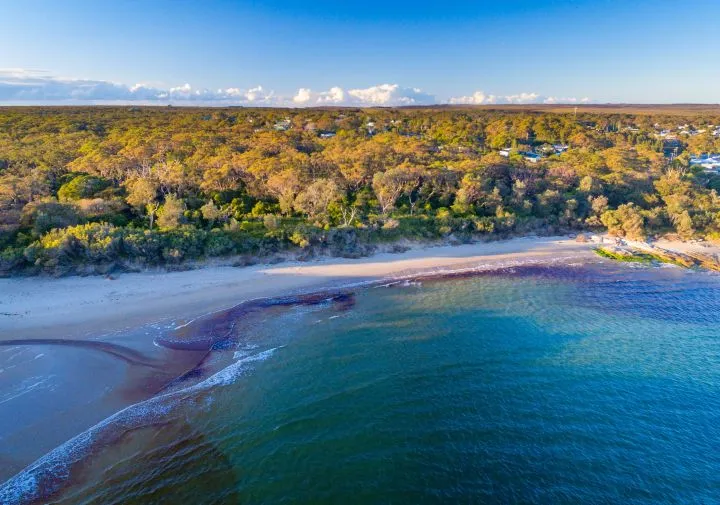Life is a journey. Time is a river. The door is ajar
Lemon Tree Cottage is a traditional 1950 seaside cottage which is 200m to beautiful Warrain beach. It was renovated in 2013 and there are four bedrooms (2x Queen + 2 singles + trio bunk; blankets and doonas provided); 3 bathrooms a large kitchen family room; and a second large lounge room; perfect for holidaying families sleeps 8 comfortably
Lemmon Tree House
Currarong Beach has a sheltered swimming area at the southern end as well as the rivermouth to Currarong Creek, and is a popular spot for swimming, picnicking, snorkelling and kayaking. The creek is also used for launching small fishing boats. The nearby village of Currarong is a gateway to Abraham's Bosom and Point Perpendicular and is a great base for bushwalking and beach days.
Currarong is a small coastal fishing and tourist village in the Shoalhaven area of New South Wales, Australia. At the 2011 census, Currarong had a population of 452.
The village is a haven for fishermen, with several underwater rises where fish are abundant. Currarong has a small general store, a newsagent and a cafe.
Artists' works include photography, political cartoons, botanical printing, woodwork, painting, pottery, glasswork, screen printing and much more
It is easy to participate, just visit www.currarongarttrail.com.au/ where you will find information about each artist and an art trail map showing studio locations.
Simply choose which artist you would like to visit, plan your walking route around the village and visit the artists in their studios between the open hours of 10am and 2pm on the first Saturday of each month.
Much awaited Currarong Art Trail to become a reality
Caught in the net
ecareer errors
Danger date: 2001
Problem: Ill-chosen joint-venture partners
Lessons:
* Stick to the products and services you are good at.
* When teaming up with another business, hire outside analysts to conduct due diligence to make sure they can deliver what they promise.
Wise words: You never get everything 100 per cent right. If you don't make the odd mistake, you are probably not trying hard enough.
Two years after starting the Sydney recruitment firm ecareer (ranked 95), founders Brian Walker and Sue Selby were ready for a new challenge. With revenue reaching $5 million in 2001, they jumped on an opportunity to cash in on the rise of the internet. "We wanted to set up an online recruitment system that would enable our clients to automate some of their human-resources processes," Walker says.
They teamed up with a local information technology firm that promised to develop the online software for ecareer. Reassured by a strong working relationship that dated back five years, Walker and Selby formed a joint venture with the firm, named the software, and Walker signed cheques to fund the software development. "We thought they had the technological expertise. We had the business knowledge, so it seemed like a marriage made in heaven," Walker says.
One year and $100,000 later, he was shocked to discover that their partner would not be able to finish the product because the employee who did the computer programming had left six months earlier.
"The knowledge [needed to finish the software] was with one person," Walker says. "It was like owning a half-finished house. We paid for the house upfront, expecting it to be finished, but the builder went broke. What can you do?"
To make matters worse, Walker was also mired in a court battle with an overseas competitor who alleged that the new software, which ecareer had trademarked in anticipation of its release, breached a trademark that had already been granted.
Just as Walker realised that the joint venture would never get off the ground, he lost the trademark case and was forced to give up rights to the name in Australia. "We really had to stand back and lick our wounds," he says.
By June 2002, the joint venture was worthless, and Walker and Selby were forced to walk away. "In hindsight, we listened to what they offered and they were convincing," Walker says. "We invested based on trust. We should have sent someone technical in to do due diligence on the software."
Five years later, Walker says the failed foray into software may be the best thing that has happened to ecareer. "It forced us to sit back and think about our business. We realised that we're not a software developer, we're a recruitment firm. We are better off building that business than spinning off into things outside our areas of expertise." Revenue climbed to $15 million in 2005-06 and Walker believes
ecareer's turnover will exceed $20 million in 2006-07.
As part of the strategy to build on its areas of expertise, Walker and Selby have poured resources into recruitment brands for the financial services sector, the travel industry and general recruitment. To attract the best quality staff for its databases, ecareer supplies candidates only to big-name employers such as Westpac, the Commonwealth Bank and BNP Paribas. "Being really selective about the companies we choose to work for attracts the best candidates," Walker says.

